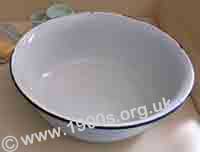Kitchen sinks, taps and draining boards in 1940s kitchens
As this group of pages show, kitchen equipment and decor in the 1940s had changed considerably since the early years of the 20th century. This could not be said of the kitchen sink. This page shows pictures of such sinks from museums and old houses and gives commentaries on their features.
____
By the webmaster, based childhood observations, discussions with people who lived in these houses and additional research
The sink and draining board that I remember in my parents' 1940s suburban kitchen were fitted in the late 1930s and due to the shortages and austertiy of the war remained up-to-date into the 1940s and early 1950s.
The sink and taps
The design of the sink itself was like the early 1900s sink of my mother's childhood except that there was a hot tap as well as a cold one. Unlike the taps of today which are set into sinks and basins, both these taps came out from the wall just like the early 1900s tap. A difference, though, was that the wall in the 1940s kitchen was tiled with white tiles just like those in the bathroom. I have never seen an identical arrangement in any of the museums I have visited, so there is no accurate photograph.
The taps were basic as shown below, set into the wall connection. Unlike in the photo, though, the tiles were the standard square, not rectangular.
An enamel bowl was kept in the sink for washing up, as the sink itself, being so large, was wasteful of hot water.

Stoneware sink, common in kitchens and sculleries before the 1950s. The left hand edge of a wooden draining board can just be seen on the right. A white tiled wall would be behind.

Typical taps with large gripping knobs, plumbed directly into the white tiled wall behind.
The sink was the standard large white stoneware, called as I have since learnt, a Butler sink.
The sink was mounted in position on metal brackets. On the floor underneath the sink was a space with various other bowls and buckets plus the standard household soap with a carton of washing soda. In many houses, this area was hidden with a short curtain hung on wire, but my mother disliked that arrangement and our area was in full view, U-bend and all.
Both the soap and the soda were used together for washing up.
The draining board
The sink had a white enamel draining board attached which I never saw on other housing estates of the same period. There, all the draining boards seemed to be wooden. In fact, it took me some years to find an enamel one to photograph. I finally found this one in Llanerchaeron House in Wales.

White enamel draining board, mounted against the sink on metal brackets.

Wooden draining board, photographed in Tilford Rural Life Centre.
Our enamel draining board was mounted on visible metal brackets at the side of the sink. I always thought how clean it looked compared with the wooden ones. Bare unvarnished wood always looks rather grubby when wet. I suspect that enamel draining boards were more expensive than wooden ones. They did chip, though, which left black marks.
The end of these sinks and draining boards
Years later, sink and draining board arrangements were replaced by integral sink units with cupboards underneath. There were no integral sink units in ordinary 1940s houses, in spite of what museums and magazines may imply. I cannot of course speak for better-off households, but since design is led by availability of materials, I doubt it.
Before the mid or late 1950s, the space under our draining board was empty, except for the occasional bucket or bowl. When my mother was persuaded to part with her old mangle for a spin dryer, that space was where it went.
| sources | webmaster | contact |
Text and images are copyright
If you can add anything to this page or provide a photo, please contact me.




